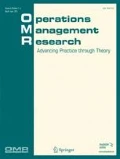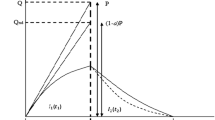Abstract
The paper presents a modeling framework that assists management to allocate capital resources to improve the yield and the yield variability in a multistage production system. The results indicate that production stages with low yield and/or high yield variability receive more capital resources for improvement. The applicability of the model is demonstrated in a real-life manufacturing firm in the food-packing industry. The solution of the model provides directions of improving the stages of a multistage production system.





Similar content being viewed by others
References
Akella R, Rajagopalan S, Singh MR (1992) Part dispatch in random yield multistage flexible test systems for printed circuit boards. Oper Res 40:776–789
Bohn R, Terwiesch C (1999) The economics of yield-driven processes. J Oper Manag 18:41–59
Chase RB, Jacobs FR (2011) Operations and supply chain management. McGraw Hill, New York
Denardo EV, Tang CS (1992) Linear control of a Markov production system. Oper Res 40:259–278
Denardo EV, Lee TYS (1996) Managing uncertainty in a serial production line. Oper Res 44:382–392
Fisher ML, Ittner CD (1999) The impact of product variety on automobile assembly operations: empirical evidence and simulation analysis. Manag Sci 45:771–786
Grosfeld-Nir A, Gerchak Y (2002) Multistage production with rework capability. Manag Sci 48:652–654
Grosfeld-Nir A, Magazine M, Van Berkel A (2000) Push and pull strategies for controlling multistage production systems. Int J Prod Res 38:2361–2375
Hadjinicola GC (2010) Manufacturing cost in serial production systems with rework. J Oper Res Soc 61:342–351
Hadjinicola GC, Soteriou AC (2003) Reducing the cost of defects in multistage production systems: a budget allocation perspective. Eur J Oper Res 145:621–634
Hwang J, Singh MR (1998) Optimal production policies for multi-stage systems with setup costs and uncertain capabilities. Manag Sci 44:1279–1294
Lee HL (1996) Input control for serial production lines consisting of processing and assembly operations with random yields. Oper Res 44:464–468
Lee HL, Yano CA (1988) Production control in multistage systems with variable losses. Oper Res 36:269–278
Lee HH, Chandra MJ, Deleveaux VJ (1997) Optimal batch size and investment in multistage production systems with scrap. Prod Plan Control 8:586–596
So KC, Tang CS (1995) Optimal operating policy for a bottleneck with random rework. Manag Sci 41:620–636
Tang CS (1990) The impact of uncertainty on a production line. Manag Sci 36:1518–1531
Tal B, Grosfeld-Nir A (2010) Multistage production systems with random yields and rigid demand. Int J Manuf Technol Manag 20:286–299
Teunter RH, Flapper DP (2006) A comparison of bottling alternatives in the pharmaceutical industry. J Oper Manag 24:215–234
Van der Zee F, Brandes F (2007) Manufacturing futures for Europe—a survey of the literature. Report for framework service contract B2/ENTR/05/091, TNO, The Netherlands
Wein AS (1992) Random yield, rework and scrap in a multistage batch manufacturing environment. Oper Res 40:551–463
Author information
Authors and Affiliations
Corresponding author
Appendices
Appendix A
Proof of Proposition 1
Using Eqs. 3 and 6 and introducing the Lagrange multiplier λ we obtain
From Eq. 9 we obtain the following first order conditions:
Solving Eq. 10 for ϵ ij we obtain
where a ij is defined as in Eq. 6. Substituting Eqs. 12 in 11 and after simplifying, we obtain the solution in Eqs. 5 and 6.□
Proof of Proposition 2
Taking the derivative of the objective function in Eq. 7, with respect to ϵ ij , equating to zero and simplifying, we obtain the solution in Proposition 2.□
Proof of Proposition 3
Condition 1 is implied from Eq. 5 since \(\epsilon^\ast_{ij} \geq 0.\) Condition 2 stems from Eq. 5 where \(\epsilon^\ast_{ij} \leq 1.\) Condition 3 stems from Eqs. 8 and 6 since \(\epsilon^{\ast\ast}_{ij} \leq 1.\)□
Appendix B
The model presented in HSD uses the following notation:
- y j :
-
Mean yield of production stage j, j = 1, ..., N.
- c j :
-
Expected cost incurred from a defect observed at production stage j.
- n j :
-
Annual number of products processed at production stage j.
- N :
-
Number of production stages in the multistage production system.
- AC :
-
Annual expected cost incurred from defects observed in all production stages.
- B :
-
Budget available for improving the yield of the production stages.
- h j :
-
A parameter that characterizes the investment needed to improve the yield loss, 1 − y j , at production stage j.
- ε j :
-
The remaining percentage of the initial yield loss (1 − y j ) after improvement in yield has been established. In other words, 1 − ε j represents the percentage improvement or reduction in the initial yield loss at production stage j.
The mathematical program in HSD is given by:
The objective function represents the annual expected cost incurred from defects after improvement has been implemented and the constraint represents the budget availability.
The solution to the HSD model is given by:
The solution results in an optimal budget allocation that minimizes the annual expected cost incurred from defects observed in all production stages, by reducing the yield loss (1 − y j ) at production stage j to \((1-y_j)\epsilon_j^\ast.\)
Rights and permissions
About this article
Cite this article
Hadjinicola, G.C., Soteriou, A.C. The effect of yield variability on the decision to improve the performance of multistage production systems. Oper Manag Res 5, 3–13 (2012). https://doi.org/10.1007/s12063-012-0061-2
Received:
Revised:
Accepted:
Published:
Issue Date:
DOI: https://doi.org/10.1007/s12063-012-0061-2



